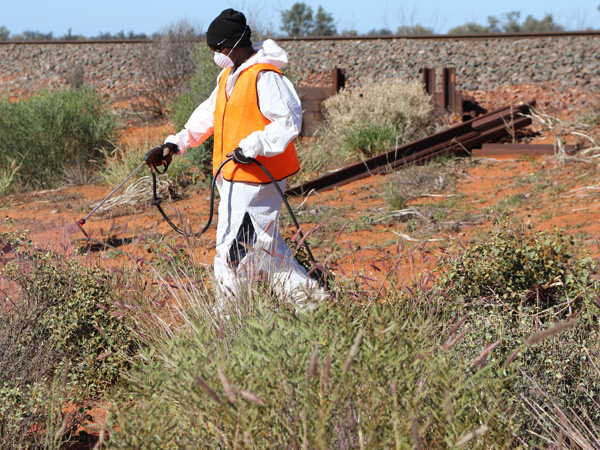Buffel grass management in the Alinytjara Wilurara Region
By Natural Resources Alinytjara Wilurara
Initially introduced into central and northern Australia for pasture improvement and dust control, buffel grass (Cenchrus ciliaris) continues to spread across the northern deserts of South Australia, transforming the landscape and impacting heavily on biodiversity. For Aboriginal people who have lived in these regions for countless generations, this invasion is deeply concerning.
Although buffel grass is widely considered the species of choice by pastoralists because of its wide adaptation ability and tolerance of drought, fire and over-grazing, it’s also an aggressive coloniser and was declared a weed by the South Australian Government in 2015. Curtailing its spread has become a key objective of the Department of Environment, Water and Natural Resources’ (DEWNR) Alinytjara Wilurara (“north-west” in Pitjantjatjara) Natural Resources Management (AW NRM) Board.
Spanning more than 250,000 square kilometres, the AW NRM Region covers over a quarter of SA including a large proportion of the Great Victoria Desert (GVD). Despite bordering the Anangu Pitjantjatjara Yankunytjatjara Lands where buffel grass is thought to be irrevocably established, outbreaks within the GVD have been limited to a few isolated locations.

Controlling the spread of buffel grass is paramount in South Australia.
Trains travelling east to west along the Trans-Australian Railway line inadvertently carry and distribute buffel grass seed from infested areas to relatively untouched landscapes in the AW region. This necessitates constant monitoring and management of outbreaks occurring along the railway tracks and verges.
Natural Resources Alinytjara Wilurara, in supporting the AW NRM Board, delivers hands-on training for community members to support them in effectively monitoring and destroying buffel grass while maintaining best practices in land management. These management strategies are particularly relevant at a local level where it causes significant loss of native flora and fauna, and negatively impacts on Indigenous cultural practices, including hunting and collecting bush tucker.
Being significantly more flammable than native grasses, it produces high-intensity fires which damage ecosystems never previously exposed to such extreme temperatures. Such fires also present a risk of damage to valuable infrastructure and property, as well as threaten the well-being of people living in remote communities across the region.
Whereas traditional Aboriginal patch-burning encouraged regrowth of native grass species, the heat produced by burning buffel grass destroys native plants both above and below ground. Aboriginal women have also pointed out that they are reluctant to engage in traditional gathering practices because of the thick buffel grass decreasing visibility of snakes.
With the GVD being one of the last deserts in Australia that maintains its pre-colonial biodiversity, the importance of managing the land and keeping it free of buffel grass is immeasurable. In SA, Natural Resources Alinytjara Wilurara is taking the lead on working towards a “Buffel Free GVD”, while in Western Australia, Spinifex Land Management, supported by the Rangelands NRM Alliance, are playing a crucial collaborative role.
The AW NRM Board directs management strategies to prevent the spread of buffel grass seed and the formation of monocultures across the GVD, around Aboriginal communities and along various transport routes. The battle to keep SA’s southerly agricultural areas free of buffel grass begins with keeping our desert regions healthy by using best practice land management techniques.



